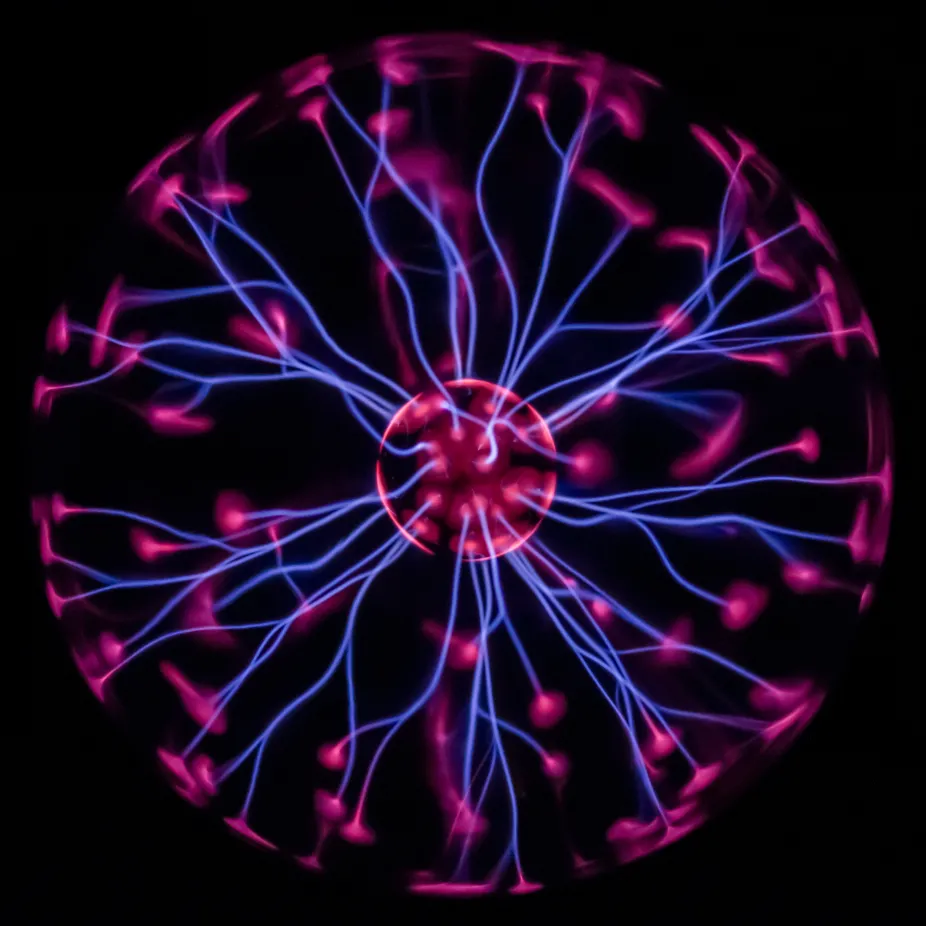Plasma

Multiple beams of colored plasma filaments can be seen oscillating within this plasma ball. A plasma ball is usually a clear glass sphere filled with a mixture of noble gases, such as neon and argon. A plasma is formed when voltage is applied to an electrode in the center of the glass sphere.
Wikimedia Commons
Plasma is one of the four common states of matter - solid, liquid, gas, and plasma. Plasma is an electrically charged gas. Because plasma particles have an electrical charge, they are affected by electrical and magnetic fields. This is the main difference between a gas and a plasma.
Plasma is charged gas molecules
A plasma is created when one or more electrons are torn free from an atom of gas. Atoms that have lost some or all of their negatively charged electrons are called ions. An ionized atom has a positive charge because it is missing electrons, but still contains positively charged protons and neutrons (with no charge) in its atomic nucleus. A plasma is generally a mix of these positively charged ions and negatively charged electrons.
Most plasmas are created when extra energy is added to a gas, which can occur when gases are heated to high temperatures. Atoms in a hot gas are moving so fast that electrons can be knocked loose when they collide with each other. High energy photons from the Sun, including gamma rays, X-rays, or ultraviolet radiation, can create plasma by knocking electrons away from their atoms. High-voltage electricity, such as from lightning strikes, can also create plasmas.
Plasma is the most common state of matter in the universe
Matter in the plasma state is far more abundant than matter in the liquid, solid, or gaseous states. 99 percent of all matter, other than the mysterious "dark matter" that astronomers have been puzzling over, is plasma. Most of the matter in the Sun and other stars exists in a plasma state.
Though common in the universe, plasma is less abundant on Earth. Regions of Earth's atmosphere called the ionosphere contain some plasma that is created through ultraviolet radiation from the Sun. The upper layers of Earth's atmosphere, the thermosphere and exosphere (and to a lesser extent the mesosphere), also contain plasma mixed in with atoms and molecules of different gases. Above the atmosphere, Earth is surrounded by a magnetic field called the magnetosphere. Most of the particles in the magnetosphere are ionized plasma.
Plasma creates glowing light shows in the sky

The green lights above Earth's surface are the aurora (northern lights and southern lights), as seen from the International Space Station on July 25, 2010. Auroras primarily occur in Earth’s thermosphere, which is an upper layer of the atmosphere.
Science & Analysis Laboratory, NASA Johnson Space Center
Plasma in Earth's magnetosphere sometimes flows along Earth's magnetic field towards the polar regions, creating the colorful light shows in the sky which we call the aurora, or northern and southern lights. These beautiful displays occur when energetic plasma particles collide with gases in the atmosphere, causing them to glow.
Solar prominences, which are giant loops of glowing matter suspended above the Sun, are another example of beautiful natural light shows created by plasmas. Though invisible to the eye, the solar wind that is constantly streaming out from the Sun contains large amounts of plasma along with various types of solar energy.
Plasma can be created artificially
Some plasmas are created artificially by humans. Electricity in fluorescent lights creates a plasma. Colorful neon lights, often used in signs, also use electricity to convert gas molecules into glowing plasma. Certain types of flat-screen televisions make use of plasma as well.